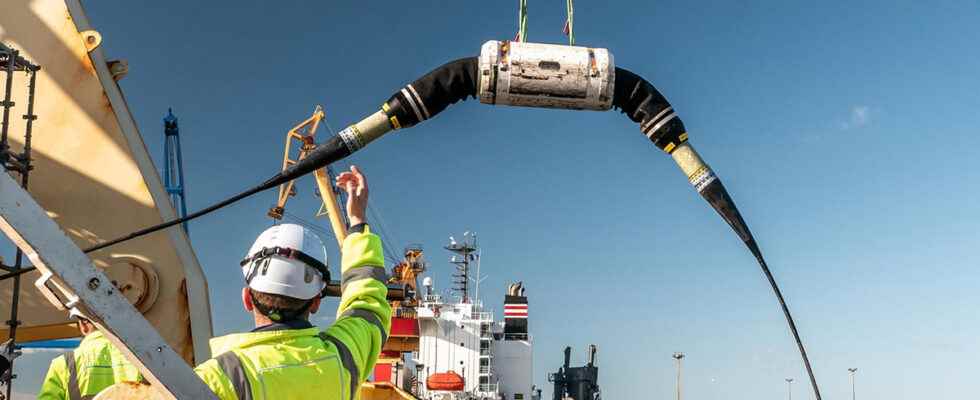Image: ASN.
The Alcatel Submarine Networks (ASN) site in Calais has won the title of the largest 5G connected factory in Europe. The Free Pro and Free Mobile teams have deployed a private 5G network which, with 57 indoor access points and 2 outdoor access points, covers 11 buildings for a total area of 50,000 m2.

Image: ASN.
Supported for two years, this project called “Industry 4.0” aims to improve the productivity, quality, traceability and safety of the operations of this manufacturer of submarine cables. ASN produces 50,000 km of cables per year while ensuring installation and maintenance throughout the world.
A subsidiary of Nokia France, ASN has of course called on Nokia Digital Automation Cloud, the Finnish equipment manufacturer’s private 5G network connectivity platform. The radio part of the network uses Free Mobile’s 5G 3.5 GHz frequencies.
The benefits of private 5G are now known. By relying on its own infrastructure, a manufacturer becomes independent of the public network of operators. It benefits from a guaranteed quality of service in terms of throughput and latency. Security is also increased. Access to ASN’s 5G network is restricted to people with a specific SIM card and all data remains internal.
Digitization of manufacturing procedures
Drawing on its strengths, ASN has already identified five major use cases. The first is related to the digitization of manufacturing procedures. The design of an undersea fiber optic cable is done in six steps including coloring, insulation or assembly.
Until now, these procedures were carried out manually, on paper. Now equipped with mobile terminals, operators can update production logs in real time. This information then feeds the company’s various information systems: the PLM, the ERP and the execution tools.

Image: ASN.
The elimination of manual document consultation and creation tasks drastically reduces the risk of error and ensures better traceability of information. With regard to particularly sensitive data, private 5G also offers an unequaled level of access and transmission security. Authentication is based on the unique and encrypted SIM card and the identifier of the network access point or APN (Access Point Name).
The filling measurement of storage tanks
Once manufactured, the cables are stored in large tanks awaiting their assembly, with the addition of repeaters and other junction systems, then their loading on a ship to be deployed at sea. The Calais plant has 130 of these tanks.
Here again, tank filling rate declarations were entered manually by operators into the information system (IS), with the risk of input error and uncertainty inherent in this type of operation. However, these are critical data for the Calais site, as the availability of tank space conditions the production of cables.
Above each tank, the manufacturer has installed a laser which measures with very high precision, to within 1 mm, the filling rate of the tanks. The information is transmitted in real time, via a web application, to the operators and integrated into the IS.

Image: Iliad.
This data is then consolidated in a dashboard that lists information from the various production lines in the plant. Their collection and processing should allow better anticipation of production management. Eventually, this data will also be used for predictive purposes. The density and reliability of the private 5G network makes it possible to connect the 130 tanks located over a large perimeter, but also to cover the IoT equipment (connected sensors).
Remote maintenance
Private 5G has also changed the approach to maintenance. Each production workshop is equipped with machine tools, the maintenance of which has until now been carried out in the traditional way. In the event of an incident, the dedicated team intervened on site to establish the diagnosis and then intervene. The incompressible delay of these interventions had a strong impact on productivity.
5G connectivity has made it possible to deploy a remote maintenance solution. Wearing connected glasses, the operator interacts with an expert located remotely, while keeping his hands free. The latter guides him in real time throughout the duration of the intervention.

Image: Iliad.
Remote maintenance has several advantages. It optimizes the availability of machine tools, with repairs and resumption of production being able to take place as soon as the incident is observed. It also reduces travel, and therefore the carbon footprint, of support teams. ASN is currently working to reference, for each type of machine, the most suitable supplier to provide remote support.
Remote maintenance needs potentially apply to all ASN products and machines, including those located in the port area, or even on docked ships. This presupposes having reliable indoor/outdoor coverage ensuring very high-speed data transmission.
Analysis of production incidents
Incidents on production lines have a direct impact on productivity. For each of them, they entail a service interruption of at least 8 hours, the time needed to stabilize the line and restart production. If they occur during the phase of increasing the power of the welding laser, the origin of certain incidents remains unexplained. Furthermore, the machines concerned are not connected to the internet or to ASN’s IS.
As part of the Industry 4.0 project, a connected camera connected to a computer vision system was positioned on the production line. It will make it possible to collect data during the phase of increasing the power of the laser in order to understand the origin of the malfunctions. In the future, this device will automatically recognize the configurations conducive to generating failures and will preventively trigger upstream quality controls.

Image: Iliad.
Optimization of energy consumption
By multiplying the sensors connected in the various buildings on the site, ASN plans to continuously measure electricity or water consumption and then consolidate this data in a dashboard. With a global view of its energy consumption, the manufacturer can take ad hoc savings measures.

Image: ASN.
